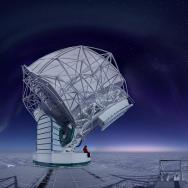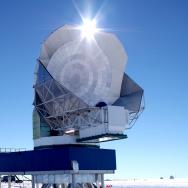The largest collaborative undertaking yet to explore the relic light emitted by the infant universe has taken a step forward with the selection of Lawrence Berkeley National Laboratory to lead the U.S. Department of Energy’s portion of the project.
This next-generation experiment, known as CMB-S4, or Cosmic Microwave Background Stage 4, will unite several existing collaborations to survey the microwave sky in unprecedented detail. The plan calls for 500,000 ultrasensitive detectors on 21 telescopes located in two of our planet’s prime places for viewing deep space: the South Pole and the high Chilean desert. The project, which is estimated to cost several hundred million to build, is intended to unlock many secrets in cosmology, fundamental physics, astrophysics and astronomy.
As with the construction of new cameras for the first South Pole Telescope, which have made breakthrough observations of the skies and early universe, the Department of Energy and National Science Foundation are partnering to build the new telescopes. Last year, the NSF announced it was tapping the University of Chicago to lead the development for the NSF part of the project.
Department of Energy Office of Science Director Chris Fall authorized the selection of Berkeley Lab as the lead laboratory for the DOE roles and responsibilities for the construction of CMB-S4, with Argonne National Laboratory, Fermi National Accelerator Laboratory and SLAC National Accelerator Laboratory serving as partner labs. The CMB-S4 science collaboration now numbers 236 members at 93 institutions in 14 countries and 21 U.S. states.
Formerly established in 2018, the CMB-S4 collaboration has two current co-spokespeople: Julian Borrill, head of the Computational Cosmology Center at Berkeley Lab and a researcher at UC Berkeley’s Space Science Laboratory, and John Carlstrom, the Subramanyan Chandrasekhar Distinguished Service Professor at the University of Chicago and scientist at Argonne.
“Ever since CMB-S4 was conceived, we have been working to pull the collaboration together and build the team, and we are now working toward a final design so we can start construction on a very short timescale,” Carlstrom said. “This has been a terrific project—there’s a lot of enthusiasm. There’s much remaining to learn from the cosmos, and CMB-S4 will take us a significant step further in our understanding of the universe.”
Combining a mix of large and small telescopes at both sites, CMB-S4 will be the first experiment to access the entire scope of ground-based CMB science. It will measure ever-so-slight variations in the temperature and polarization, or directionality, of microwave light across most of the sky, to probe for ripples in space-time associated with a rapid expansion at the start of the universe, and determine the energy scale of that expansion, known as inflation.
CMB-S4 will also help to measure the mass of the neutrino; map the growth of matter clustering over time in the universe; shed new light on mysterious dark matter, which makes up most of the universe’s matter but hasn’t yet been directly observed, and dark energy, which is driving an accelerating expansion of the universe; and aid in the detection and study of powerful space phenomena such as gamma-ray bursts and jet-emitting blazars.
What’s unique about CMB-S4 is not the technology itself—the detector technology has already been proven in earlier experiments, for example—but the scale at which the technology will be deployed, including the sheer number of detectors, scale of the detector readout systems, number of telescopes and volume of data to be processed. While previous generations of instruments have used tens of thousands of detectors, the entire CMB-S4 project will require half a million. It will have the combined viewing power of three large telescopes and 18 small telescopes.
The result is that CMB-S4 will exceed the capabilities of earlier generations of experiments by more than 10 times.
A major hardware focus for the project will be the construction of new telescopes and the mass-fabrication of the detectors. The current detector design, adapted from current experiments, will feature over 500 silicon wafers that each contain 1,000 superconducting detectors. The data-management challenges will be substantial, as these huge arrays of detectors will produce 1,000 times more data than the previous generation of experiments.
UChicago-affiliated Argonne and Fermi national laboratories will also play roles in the construction.
Argonne and Fermilab expect to work on the development of the detectors and cameras, which have to operate at 0.1 Kelvins—a fraction of a degree above absolute zero—to achieve the requisite sensitivity.
“Drawing upon expertise in materials, sensors and superconductivity, Argonne’s CMB research is more than a decade old and has honed our leadership in developing and fabricating the very sensitive detectors and readout technology used for state-of-the-art CMB measurements,” said Kawtar Hafidi, associate laboratory director for Argonne’s Physical Sciences and Engineering Directorate. Argonne will also play a role in computational cosmology and survey science for the project.
“Fermilab has been a pioneer in developing cosmic surveys, such as the Sloan Digital Sky Survey, the Dark Energy Survey and, most recently, the South Pole Telescope SPT-3G Survey,” said Brad Benson, associate professor of astronomy and astrophysics at the University of Chicago and a Fermilab scientist. “Now with CMB-S4, we’re excited to be planning contributions to the R&D and construction of new cameras, which will be an order of magnitude more sensitive than anything previously built.”
The project is expected to deploy its first telescope in 2027, to be fully operational at all telescopes within a couple of years, and to run through 2035.
The National Science Foundation has been key to the development of CMB-S4, which builds on NSF’s existing program of university-led, ground-based cosmic microwave background experiments. Four of these experiments—the Atacama Cosmology Telescope and POLARBEAR/Simons Array in Chile, and the South Pole Telescope and BICEP/Keck at the South Pole—helped to start CMB-S4 in 2013, and the design of CMB-S4 relies heavily on technologies developed and deployed by these teams and others. A grant awarded to the University of Chicago last year is helping plan the project’s future.

